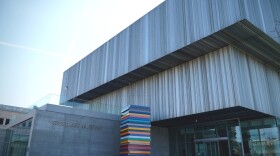With her mixed media artwork “The Bricks,” Jaylin Stewart reimagined the idea of a contemporary mural, taking an outdoor scene and building it indoors.
Depicting multiple generations of a family in front of a home, the piece is a nod to community, but it also bridges the gap between the more traditional definitions of street art and fine art.
“‘The Bricks’ is a scene, a set-up, a monument created to replicate the projects in Louisville, really highlighting Black women, telling the story of each Black woman from all ages and generations that come from these spaces,” Stewart said.
It is one of the many thoughtful and conceptual pieces currently showing in KMAC’s exhibition “Wild in the Streets,” a layered show that features decades of creations from artists inspired by urban settings. The exhibit has work from more than 20 artists, including renowned locals such as Ezzit Whurr, Mark Anthony Mulligan, Tom Pfannerstill and Licia Priest, as well as acclaimed artists from elsewhere, like Barton Lidice Benes, Richard Hambleton and Chris Johanson.
“Each one of us brought a different experience in this collective space,” Stewart said.
The exhibition contains graffiti-inspired paintings, satirical signs, streetscape models, woodwork made from skateboard decks, hyperrealistic wood carvings painted to look like pieces of litter and more.
“It shows many different levels and generations of how the word graffiti and how the term street art has transformed throughout the years,” Stewart said. “It’s showing the evolution of art in this realm.”
“Wild in the Streets” shares its title with the 1973 song by Garland Jeffreys. That track was about challenging the status quo. So is this exhibition.
KMAC Curatorial Director Joey Yates said that the idea of the exhibit wasn’t to simply recreate or only show traditional street art, but to provide a pathway for artists to create in new ways. The show also features several people who have already broken barriers, like transitioning from tagging walls to showing in galleries.
“A lot of times street art, graffiti writing, a lot of that belongs in the street, because that’s its habitat in a way. So when it comes into the gallery, it can lose some of that resonance, some of that subversion — it kind of robs it of it,” Yates said. “While we’re trying to give a platform to all kinds of art and art practices, we also want to help professionalize what they’re doing.
The Shadowman and The Art Of Litter
In the 1980s, Richard Hambleton became known as “the Shadowman,” after hundreds of his striking, splattered black-paint silhouettes started popping up in New York. He once even tagged the Berlin Wall.
In the following years, he converted his iconic images to canvas and paper, and showed them in high-profile gallery spaces across the globe, including the Museum of Modern Art.
Two pieces of his work are featured in “Wild in the Streets.”
While Hambleton’s story captures being able to walk the line between what is generally thought of as street art and fine art, the most impressive thing about the show at large is how deeply layered the styles and interpretations of that overarching concept are.
Not far from Hambleton’s work are painted wood carvings that look like mirror images of trash found on the street.
Those are made by Louisville artist Tom Pfannerstill, who has been working on the extremely realistic series for the last 30 years.
He never hit walls in the middle of the night like “the Shadowman” did. He’s inspired by the street in a different way.
In “Wild in the Streets,” Pfannerstill has pieces that resemble battered and discarded pieces of trash he found — a 12-pack of Miller Lite, a bucket of KFC, a Little Caesars pizza box.
There’s something existential about the cycle of litter for him.
“I became very aware of time and how short a lifespan is, and I wanted to depict that…What’s more ephemeral and short-lived than trash that you see in the street?” Pfannerstill said. “These little objects sort of had their lifespan and I found them at the end of that little lifespan and they served their purpose. I just found that interesting, to use them as notations of time.”

Being There
“Wild in the Streets” shines a light on the different meanings, the different perspectives and the many layers behind street art.
The first floor of the show includes an abstract sculpture from Kiah Celeste who uses discarded and found materials; Lori Nix and Kathleen Gerber’s post-apocalyptic imagery of nature retaking city environments made by building small models and manipulating them to look massive; and Thaniel lon Lee’s photography series where he chronicles accessibility issues by dragging a canvas behind his wheelchair.
The second floor is dedicated to art that features imagery of the street. That’s where Stewart’s “The Bricks” lives, as well as some of Mark Anthony Mulligan’s surreal yet evocative pen-and-marker Louisville streetscapes; a bustling traffic scene built out through layers and layers of paper by Licia Priest; a fingerboard skate park, created by Derek Toomes and Lee Walton, that’s hooked up to an amplifier to fill the room with sound and more.
“I didn’t want it to be limited, or a one or two dimensional show about street art. I kind of wanted to give as many possibilities as I could,” Yates said. “The way I kind of talk about it, is it’s not only artists who work in the street, but are inspired by the street.”
“Wild in the Streets” is showing at KMAC through May 19.






